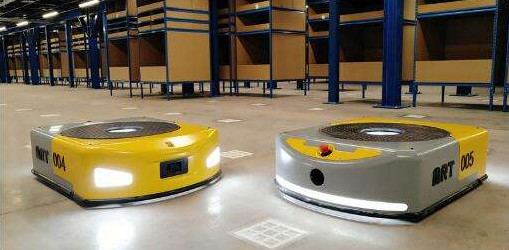1. AGV Reliability
The statistical results of the main guiding technologies adopted by 27 series of products of more than a dozen AGV companies abroad show that, for example, the technology of AGV, the proportion of electromagnetic induction, inertial navigation, optical detection, position setting, laser detection, and image recognition They are 32.3%, 27.8%, 16.9%, 13.8%, 7.69% and 1.54%. Among them, the application rate of electromagnetic induction guidance technology is the highest, which shows that the technology is very mature. However, the application of machine vision guidance technology is less, indicating that the technology still needs in-depth research and continuous improvement. In addition, autonomous navigation technology is still in the research stage, and there are many technical problems to be solved.
 2. AGV Adaptability
2. AGV Adaptability
The adaptability refers to the restrictions on the guidance technology caused by the cleanliness of the ground, the unobstructed space of the space and the degree of photoelectric interference during the operation of the AGV. Because different steering technologies have different requirements on the application environment, the practical application of a certain steering method may be limited.
For wired guidance technologies, such as buried wire induction, optical guidance, and machine vision, the environmental requirements are mainly the levelness and cleanliness of the ground. In addition to the low requirements on the ground cleanliness of the buried electromagnetic induction type, several other methods require higher. However, the electromagnetic and magnetic tape guidance methods have high requirements on the levelness of the ground.
For the laser-guided technology used wirelessly, the environmental requirement is mainly the degree of unobstructed space. This is because this method needs to set the reflecting mirror at a specific position in the space through which the AGV runs. Therefore, it is necessary to provide enough scanning space to avoid interference from other objects.
Inertial guidance and coordinate recognition guidance technology do not have too many requirements for the operating environment.
3. AGV Flexible path
The material handling system composed of AGV has good flexibility, but the path flexibility of different guiding technologies is very different. The wireless guidance method can change the running path in a short time, and some of them only need to change the control software to change the running path. The path flexibility of the wire-based guidance method is relatively poor, and the change of the guidance path of the electromagnetic induction buried wire guidance technology is the most difficult and the cost is high.
4. AGV Running speed
The operation speed of AGV is greatly affected by the guidance technology, which mainly depends on the real-time nature of the guidance path recognition. The guidance technology used directly affects the speed of path recognition (such as detection accuracy, real-time performance and anti-interference). Wired guidance methods have fast path identification and good real-time performance, while wireless guidance methods are relatively poor.
5. AGV Stability of guidance
The degree of guidance stability refers to the number and width of corrective yaw direction control unit time for the AGV to travel along a predetermined route. Due to the influence of certain factors during the operation of the AGV, it is inevitable that the vehicle will deviate from the movement path. Therefore, in order to ensure the running direction, the vehicle must be steered, which causes the vehicle to move along the curve, causing the vehicle to oscillate, or even turn oscillation. Generally speaking, the wired guidance method has strong tracking ability of the path and good driving stability, and the AGV has a high degree of stability along the prescribed route.
6. AGV Fixed stop accuracy
The fixed stop accuracy refers to the deviation of the AGV from the predetermined position when it is stopped. It consists of two parts: direction deviation and distance deviation. In the process of material handling, AGV should be able to accurately dock with the automatic loading and unloading mechanism at the required station or cargo position. The fixed stop accuracy is an important technical indicator.
The fixed stop accuracy is directly affected by the guidance technology and is related to the control technology. The marking image recognition technology can not only identify the path markings, but also the parking marking information. The accuracy of a flexible fixed stop can reach up to 5 mm. The first-time flexible fixed stop accuracy of the electromagnetic induction buried guide technology is 20 mm. When other guide technologies are used, it is generally necessary to supplement the secondary rigid positioning measures to achieve the fixed stop accuracy requirements.
7. AGV Information capacity
Any kind of guidance technology is premised on obtaining positioning information, but the capacity of relevant information obtained by different guidance technologies varies greatly. The use of image recognition technology can not only obtain route information, but also obtain station coding, acceleration, deceleration and parking signs and other control information. The obtained information has a large capacity, which can improve route guidance and control flexibility.
8. AGV Technical cost
The technology cost of the guidance technology includes two aspects, namely manufacturing cost and usage cost. Generally speaking, the manufacturing cost of the wireless guidance method is relatively high, while the usage cost of the wired guidance method is relatively high.




